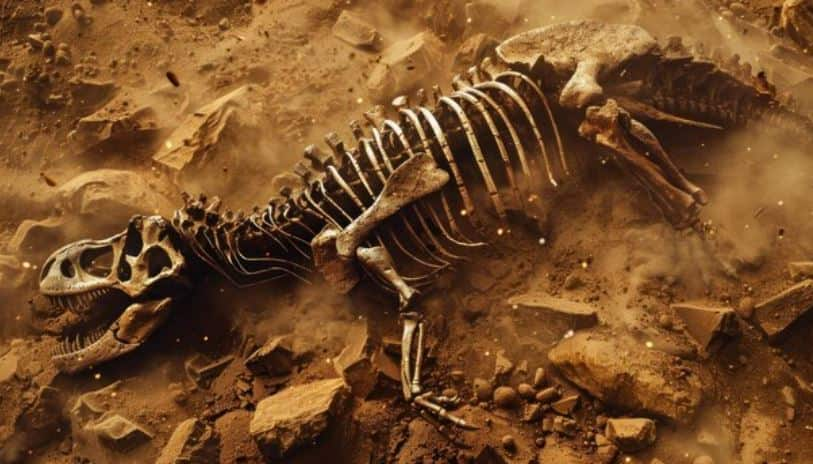A Giant So Massive It Broke the Road: In the windswept wilderness of Patagonia, Argentina, scientists unearthed a dinosaur so immense that its fossil literally shattered a paved road during transport. The colossal creature, named Chucarosaurus diripienda, stretched nearly 100 feet (30.48 meters) from head to tail, a true prehistoric behemoth.
But the discovery wasn’t just about size. When researchers examined its bones, they found something that defied everything they thought they knew about how dinosaurs of this scale managed to move and survive.
Meet Chucarosaurus diripienda: The ‘Untamable Giant’
Discovered in the Río Negro Province of Patagonia, Chucarosaurus diripienda quickly became one of the most intriguing titanosaurs ever recorded. Its name reflects both its wild discovery and fragmented condition, Chucaro meaning “untamable” in local Argentine Spanish, and diripienda from Latin for “torn apart.”
Even in pieces, its power was undeniable. When paleontologists encased the massive bones in plaster and loaded them for transport to Buenos Aires, the sheer weight, estimated at several tons, cracked a section of road. The accident, though minor, became symbolic of the fossil’s seismic scientific impact.
A Bone Structure Unlike Any Other
What’s truly rewriting the textbooks isn’t the dinosaur’s size, it’s its anatomy. Unlike other titanosaur giants that had thick, pillar-like legs to support their bulk, Chucarosaurus had unusually slender limb bones.
The fossils, which include parts of the pelvis, femur, tibia, and ischium, reveal a blend of strength and grace. Deep muscle scars hint at immense tendon attachments, yet the narrow shafts suggest a lighter, more flexible build. This unexpected combination implies a unique evolutionary strategy for achieving gigantism, one that didn’t rely on brute bulk alone.
How Big Was It, Really?
Even with incomplete remains, scientists estimate Chucarosaurus weighed around 69 metric tons, roughly ₹570 crore worth of gold in mass if converted by weight, making it one of the heaviest animals to ever walk the Earth. Its femur alone measures 1.9 meters (6.2 feet), long and surprisingly slim compared to its titanic relatives.
These proportions suggest that mass and size weren’t always directly linked in sauropods. Some might have evolved to be lighter and more mobile, challenging long-standing theories that the largest dinosaurs were slow, lumbering giants.
The Colossosauria Connection: Redefining the Giants
The research team led by Fernando E. Novas of Argentina’s Museo Argentino de Ciencias Naturales described the find in 2023, placing Chucarosaurus within the Colossosauria clade, a subgroup of titanosaurs that differ significantly from the stockier Saltasaurinae giants.
According to a study published in the Annals of the Brazilian Academy of Sciences, the diversity of limb structures in South American titanosaurs has been vastly underestimated. Some evolved legs are anchored by ligaments for flexibility and endurance rather than rigid support. This discovery means there wasn’t a single “giant dinosaur blueprint,” there were many.
New Clues About How Giant Dinosaurs Moved
Traditionally, paleontologists classified sauropods by vertebrae and body volume, but Chucarosaurus is shifting that focus to limb proportions. Its slender yet strong bones indicate that different sauropods developed multiple biomechanical strategies to bear extreme weight and still move efficiently.
The muscle scars and joint formations also hint at dynamic movement, possibly faster walking speeds or greater endurance than previously believed. This means the giants of the Late Cretaceous might not have been the slow-moving titans we imagined, but surprisingly agile for their size.
A Fossil That Shook Roads and Rules Alike
When the fossil was finally transported to Buenos Aires, the damage it caused became a metaphor for its scientific importance. The road cracked, and so did some of paleontology’s most rigid assumptions.
Now housed at the Museo Argentino de Ciencias Naturales Bernardino Rivadavia, the specimen joins a world-class collection that continues to redefine our understanding of South American dinosaurs. For scientists, Chucarosaurus diripienda is more than a fossil, it’s proof that evolution found more than one way to build a giant.
The Legacy of the “Untamable Giant”
Over 90 million years after it roamed the Earth, Chucarosaurus diripienda is still shaking things up, literally and figuratively. It challenges the idea that the biggest creatures had to be the bulkiest, showing instead that power and grace could coexist, even at 100 feet long.
As scientists continue to study its bones, one thing is clear: this is not just another dinosaur discovery. It’s a revelation about how life pushes boundaries, even when it weighs as much as a road-breaking giant from Patagonia.
Disclaimer : This story is auto aggregated by a computer programme and has not been created or edited by DOWNTHENEWS. Publisher: ZEE News







